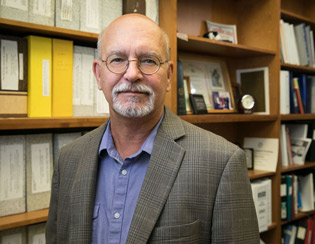Has the “Shock and Kill” Approach Been Revived?
A novel latency-reversing agent combined with natural killer cells shows promise in making the HIV reservoir a visible target
By Rowena Johnston, Ph.D.
amfAR grantee Dr. Jerome Zack, of UCLA, and colleagues have published promising findings in the January 10, 2022, issue of the prestigious journal Nature Communications. Their approach to curing HIV is widely known as “shock and kill,” in which the virus is shocked out of latency, which in turn makes infected cells visible to the immune system for killing.

There is a long history of attempts at shock and kill that have met with limited success. On the one hand, the “shock” arm of the strategy, known as a latency reversing agent (LRA), has been either safe but ineffective, or effective but unsafe. In addition, the “kill” arm of the approach has been at best only moderately effective.
Dr. Zack and his team have been studying an LRA known as bryostatin, a compound produced by bacteria that live symbiotically with a seaweed-like marine animal. Bryostatin quite potently reverses HIV latency but is considered too toxic for human use. Thus, Dr. Zack has generated analogs of bryostatin that maintain its valuable LRA properties while increasing its safety. One such analog, called SUW133, was used in the current study.
Zack and colleagues had shown previously that, on its own, SUW133 can induce the death of a subset of HIV-infected cells. They reasoned that by adding a kill agent, they could increase its efficacy even further. For this they chose to use natural killer (NK) cells, a type of immune cell that, as its name suggests, is extremely potent and efficient at killing cells.
To test their idea, the researchers generated humanized mice by irradiating young mice to remove the mouse immune system, and implanting human fetal thymus and liver tissue to generate an immune system made of human cells. This procedure allows researchers to infect mice with HIV.
After the mice were infected and treated with antiretroviral therapy, the team tested the ability of NK cells alone to decrease the HIV reservoir using the gold-standard analytic treatment interruption (ATI) test in which the time to viral rebound is measured. Only 1 of 6 mice treated with NK cells experienced viral rebound in the first week, whereas 5 of 6 untreated mice rebounded. Even when all mice experienced rebound by two weeks, NK cells appeared to slow the growth of the virus, a strong indication that NK cells are effective killing agents.
Next, the researchers combined NK cells with their shock agent SUW133. This time, 4 of 10 mice experienced no rebound at all, even when observed for an extended period. This stands in contrast to animals that received SUW133 or NK cells alone, all of which rebounded. Exhaustive searches for HIV after the conclusion of the experiment failed to detect any virus in the animals that did not rebound.
As the authors note, “the utility of combining novel LRAs and NK cells opens a new paradigm for the HIV cure field.”
The research was supported by an amfAR grant to Dr. Zack made in November 2020, and by others including NIH, UCLA, and the McCarthy Family Foundation, as well as Merck and Gilead.
Dr. Johnston is an amfAR vice president and director of research.
Share This:
